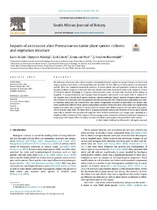| dc.contributor.author | Erckie, Laimi | |
| dc.contributor.author | Adedoja, Opeyemi | |
| dc.contributor.author | Geerts, Sjirk | |
| dc.date.accessioned | 2021-10-22T09:57:51Z | |
| dc.date.available | 2021-10-22T09:57:51Z | |
| dc.date.issued | 2021 | |
| dc.identifier.citation | Erckie, L., Adedoja, O., Geerts, S., van Wyk, E., & Boatwright, J. S. (2022). Impacts of an invasive alien Proteaceae on native plant species richness and vegetation structure. South African Journal of Botany, 144, 332–338. https://doi.org/10.1016/j.sajb.2021.09.017 | en_US |
| dc.identifier.issn | 0254-6299 | |
| dc.identifier.uri | http://hdl.handle.net/10566/6943 | |
| dc.description.abstract | The influence of invasive alien plants on plant community structure and above ground biomass in their novel range is poorly understood, as the magnitude and direction of these effects are often species and ecosystem specific. Here we compared community metrices of native plants and soil properties between study sites invaded by Hakea drupacea, uninvaded sites and cleared sites (sites formerly invaded by H. drupacea). A total of 129 plant species belonging to 75 genera were recorded across all study sites. Invasive Acacia saligna, A. longifolia, A. cyclops (Fabaceae) and Leptospermum laevigatum (Myrtaceae) co-occurred with H. drupacea in the invaded sites. Overall plant species richness, which constituted higher number of native plant species, was recorded in uninvaded sites compared to invaded and cleared sites. Plant species composition was similar between uninvaded and cleared sites, but species composition recorded in uninvaded and cleared sites
were significantly different from species composition recorded at invaded sites. Litter depth was significantly higher in invaded sites compared to uninvaded and cleared sites. Hakea drupacea did not affect soil properties in invaded sites. Here we show that H. drupacea probably reduces the diversity of native plant species especially in invaded sites probably through the effect of litter production and canopy cover, pointing to a beneficial effect of removal of H. drupacea. We encourage active restoration of sites invaded by H. drupacea at
early stages of invasion before the plants become established and suppress the growth of native species. | en_US |
| dc.language.iso | en | en_US |
| dc.publisher | South African Journal of Botany | en_US |
| dc.subject | core cape floristic region | en_US |
| dc.subject | canopy cover | en_US |
| dc.subject | invasion | en_US |
| dc.subject | litter depth | en_US |
| dc.subject | plant height | en_US |
| dc.subject | invasive alien proteaceae | en_US |
| dc.subject | vegetation structure | en_US |
| dc.title | Impacts of an invasive alien Proteaceae on native plant species richness and vegetation structure | en_US |
| dc.type | Article | en_US |

